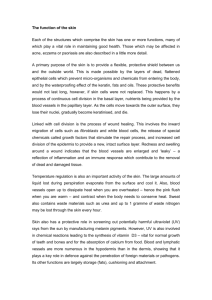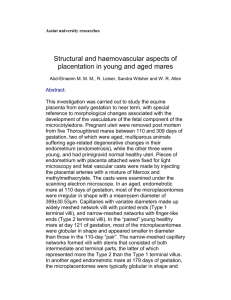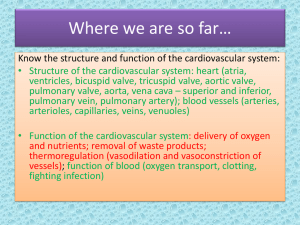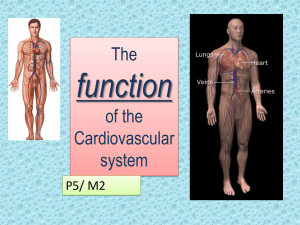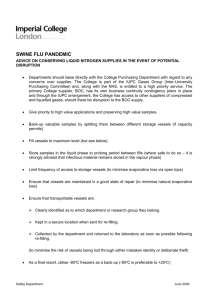MINISTRY OF EDUCATION, YOUTH, SPORTS AND RESEARCH
advertisement
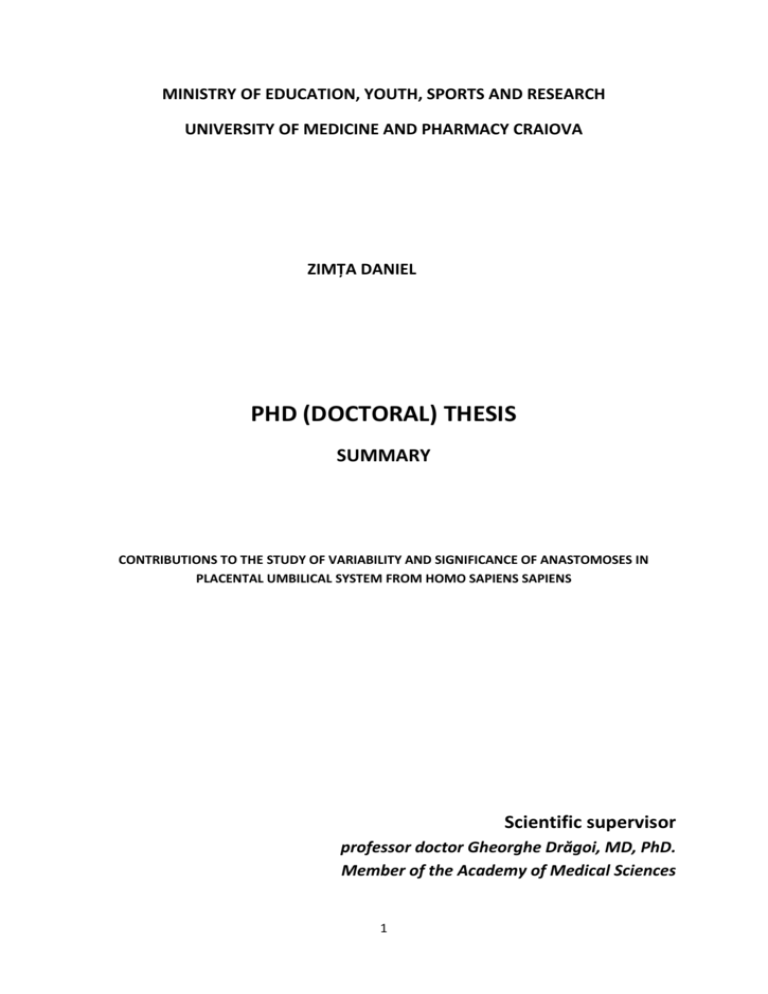
MINISTRY OF EDUCATION, YOUTH, SPORTS AND RESEARCH UNIVERSITY OF MEDICINE AND PHARMACY CRAIOVA ZIMȚA DANIEL PHD (DOCTORAL) THESIS SUMMARY CONTRIBUTIONS TO THE STUDY OF VARIABILITY AND SIGNIFICANCE OF ANASTOMOSES IN PLACENTAL UMBILICAL SYSTEM FROM HOMO SAPIENS SAPIENS Scientific supervisor professor doctor Gheorghe Drăgoi, MD, PhD. Member of the Academy of Medical Sciences 1 THE DOCTORAL THESIS CONTENT THE FIRST PART (GENERAL CONSIDERATIONS) I. INTRODUCTION A. MOTIVATION OF THE RESEARCH B. PURPOSE OF THE RESEARCH C. AIMS OF THE RESEARCH II. PROBLEMS RELATED TO THE STRUCTURAL AND FUNCTIONAL ANATOMY OF THE PLACENTA PART TWO PERSONAL RESEARCHES III. MATERIALS METHODS AND CRITERIA USED IN CONDUCTING THE RESEARCH IV. RESULTS A. THE ANALYZE OF VARIABILITY PHENOTYPE OF STEREODISTRIBUTION OF UMBILICAL BLOOD VESSELS 1. THE ANALYZE OF UMBILICAL VESSELS RELATIONS WITH CHORIONIC PLATE a. The analyze of variability insertion location of umbilical cord 2 b. The analyze variability phenotype of the distribution tree branches umbilical vessels 2. THE ANALYZE OF VARIABILITYS PUNCTURE LOCATIONS OF CHORIONIC PLATE BY BRANCHES OF THE UMBILICAL VESSELS B. THE ANALYZE OF ANASTOMOSES PHENOTYPE VARIABILITY IN THE PLACENTAL SYSTEM 1. THE ANALYZE VARIABILITY OF INTERARTERIALE ANASTOMOSES (HIRTL) 2. THE ANALYZE OF VARIABILITY PHENOTYPE OF ARTERIOVENOUS ANASTOMOSES FROM PLACENTAL SYSTEM a. The analysis of alanto chorionic mesenchymal interrelations with fetoplacentary vessels b. The stereodistribution analyze of mesenchym in chorionic villi c. The analysis of relations sinusoid capillaries from terminal villi as location of arteriovenous anastomoses c1. THE ANALYZE OF STEREO DISTRIBUTION BLOOD CAPILLARIES IN TERMINAL VILLI c2. THE ANALYZE THE LOCATION AND TYPE IV COLLAGEN RELATIONS WITH SINUSOID CAPILLARIES C2.1. The organization of type IV collagen fibers in the structure of capillary networks c2.2. Spiroidal stereo distribution of the bundles fiber of collagen in hilum terminal villi C2.3.The placental villi phenotype in normoxia and hypoxia conditions 3 V. DISCUSSIONS A. Observations on phenotypical changes of placenta mesenchym and trophoblastic as inductor factors of anastomoses variability in placenta system B. Considerations on the structural heterogeneity of terminal villi as location of arteriovenous anastomoses vein in placental system VI.CONCLUSIONS VII.SELECTIVE BIBLIOGRAPHY VIII. ANATOMIC IMAGING 4 Synthesis of the main part of the doctorate thesis The doctorate thesis is made out of two parts: a main part and a special part. The main part consists and discuses problems related to the functional anatomy of the placenta and we home stated our motivation, purpose and objectives for the research. In the special part we have presented personal research that includes five chapters: materials and methods used for the research; results of personal observations, disscusions on these results; conclusions, bibliography and anatomical imagistics. 1. Motivation, purpose and objectives of research Our doctorate’s thesis subject was justified by search for answers to numerous questions having to do with the variation of the stereodistribution of umbilical blood vessels fenotype, the radiation of the reports of alantoumbilical blood vessels to the chorionic plaque and the locations of its breaking and, not least, to the variation of the anastomosis fenotype in the alantoumbilical and choriovilositar systems. The placenta, as an organ, is fascinating for its structural simplicity and its morphofunctional multipurposes determined by fenotype transformations of two anatomy elements: citrophloblast and placentary mesenchyme. The perenity of placenta structures is determined by the fenotype transformations of the placenta mesenchyme and its interconnections to the trophoblast. Knowing the variations of the anastomoses between umbilical vessels is determined by the envolvement in the phenomenon of the inductive potentials of the placentary mesenchyme cells that have become important source to cell transplant in regenerative medicine (Brooke and col.,2008). The purpose of the thesis is knowing the variations and reports of the placentary mesenchyme within the structure of the chorionic plaque and the villous tree, on the one side, and knowing the stereodistribution of blood capillaries and implementing them in the structuralisation of chorionic villus in the last trimester of gestation on the other side, in order to understand the variations and meaning of the anastomoses of the umbilical vessels in the placentary system. The objectives of research are connected to knowing the reports of placentary mesenchyme in the two locations of the anastomoses of the umbilical vessels. The chorionic plaque for inter-arterial anastomoses (Hirtll) and the terminal villus for the arteriovenous anastomoses. For the micro-anatomical evaluation anastomoses in the arterial veins we have set out to research the sinus capillaries within the terminal villus of the third gestational trimester, knowing the reports of reciprocity between the placentary 5 mesenchyme, the sinus capillaries and the villous trophoblast, the study of the type 4 collagen stereodistribution within the terminal villus and, not lastly, the evaluation of the significance of spiral distribution of the collagen fibers fascicles around the precapillary blood vessels. To do that, numerous problems having to do with functional anatomy of the placenta to the inter-relations of the mesenchyme to the umbilical vessels were formulated, having to do with the variation of anastomoses in the placentary system. 1. What is the meaning of the two types of locations of the placentary mesenchyme: alanto-chorionic and chorio-placentary? 2. Which is the stereodistribution of the two types of mesenchyme and how does it take part in the making of compartments of the placenta? 3. Which are the effects of reciprocal induction between the chorio-villous mesenchyne and spatial distribution of the blood vessels to the birth and diferenciation of villous ramifications? 4. Does the choriovillous mesenchyme have vasculogenesis and/or angiogenesis abilities during gestation? 5. When and how in the mesenchyme organization around the ombilical vessels of their branches in the “alantochorionic parangium” and “chorio-vilozitar mesangium”done? 6. What is the anato- functional significance of the location of the mesenchyme under the trophoblast at the perifery of the villous ramifications? 7. Can the mesenchyme be considered a structure implemented in the genesis, molding and of the placenta together wit? The fibrinoid? Substance? 8. Which is the location of the placentary barrier and kow is it structural within the dynamics of the gestation? 9. How is the multiplication and structuralisation of “terminal villus” done in the third trimester of gestation? 10. What is the informational value of type 4 collagen distribution in the “terminal villus” ? 11. What is the meaning of the the placentary sinus capillaries reports to the “ sincitial knots”? 12. How is it done and what functional value are the anostomoses between the umbilical arteries within the territory of the chorionic plaque on the one side and sinus capillaries that belong to the two vasculary sources: incoming (umbilical arteries) and outgoing (umbilical vein). 6 III. Materials, methods and criteria used in research. The study was done from two perspectives: microscopic and macroscopic – by using biological materials, with specific methods and anato- functional criteria to evaluate the variations and significance of the umbilical anastomoses within the placentary system. A. Biological materials used. Macroanatomic research was done on placentae in different ways: unfixed (200 cases), injected with Tehnovit (12 cases), fixed in formaldehide 10 % concentration (30 cases), immersed in acetyc acid concentrated solution (8 cases). For the microanatomical evaluation of the structural heterogenity of the terminal villus ferrotype as a location for arterial-venous anastomoses, we have used placentary tissue fragments harvasted from the placentae of various gestational duration: 28 weeks (6 cases), 32 weeks (8 cases), 36 weeks, 37 weeks, 38 weeks. B. METHODS USED TO STUDY THE STEREODISTRIBUTION FENOTYPE VARIATION FOR THE BLOOD VESSELS AND THE VASCULAR ANASTOMOSIS FENOTYPE IN THE PLACENTARY SYSTEM. Study methods Disection MACROANATOMICAL Visualised structure Aquiring imaging Umbilical blood vessels Macrophotography Branches of the umbilical with digital camera vessels from the chorionic plaque 100 macro objective and enhancing lens Sculpture Alanto-chorial parangies Serial sections Stereodistribution of vascular structures, villous and mesenchymal MICR OANA TOMIC AL Inclusion in Serial sections to do coloration Aquiring and digital paraffin and impregnation handling of 7 Eoxine – General architecture Hematoxical microanatomical Reports of mesenchyme to the umbilical vessels, their branches images with objectives of: x4; x10; x20; x40; x63 and trophoblast Tissular Giemsa Trophoblastic and mesenchymal cellular population Argentic Gömöri Type IV collagen and its reports impregnation Vasculoscintial and sinus capillaries membranes C. CRITERIA ON WHICH PERSONAL EVALUATION WAS BASED ON. In the study of the variation and significance of umbilical blood vessels anastomoses through macroanatomical methods we were led by five anatomofunctional criteria: a. The criterion of belonging of the umbilical vessels to the subsystems that integrate the placenta in the processes of bringing nutrients, excretion and endocrine function; b. Microstereotaxic assembly criterion of the structural elements in the villus type variation; c. The criterion of reports and interactions of the structural elements by applying the “link axioma” in blood transportation units, excretionary, defense and fetus – mother exchange; d. The geometrical criterion of microstereotaxic analysis of the trophoblastic structural elements, the collagen and mesenchymal ones; e. The criterion of “reciprocal induction” within the genesis of structures through the primordial elements interactions: trophoblast and mesenchyme through complex processes of vasculo- and/or angiogenesis. IV. RESULTS OF PERSONAL RESEARCH Evaluating the variation and significance of umbilical anastomoses within the fetoplacentary system has required beforehand knowledge of blood vessels stereodistributions and of the reports of the placentary mesenchyme to the branches of the umbilical vessels, both at the level of the chorionic plaque and at the level of placentary villi. 8 A. ANALYSIS OF THE VARIATION OF THE STEREODISTRIBUTION FENOTYPE OF UMBILICAL BLOOD VESSELS In the study of the variation of the stereodistribution fenotype of umbilical blood vessels we have analysed both of macroscopic reports of the branches of the umbilical vessels to the chorionic plaque, and the locations of the breaking of the chorionic plaque by these blood vessels. 1. Analysis of the reports of umbilical vessels to the chorionic plaque Two variables were taken into consideration to evaluate the reports of the umbilical vessels to the chorionic plaque: the umbilical cord insertion location to the chorionic plaque on the one side and the branching of the umbilical blood vessels within the structure of the chorionic plaque on the other side. a. The analysis of the variation of the insertion location of the umbilical cord The insertion location of the umbilical cord onto the chorionic plaque (Chart 1) has been nominated according to the international terminology: central, excentric, marginal and velamentuos (Bernischke, Kauffman, 2004). In the central location we’ve notice a radial circumference distribution of the branches of umbilical vessels (Chart 2). In the case of excentric location the branches detach radially and occupy 2/3 of the circle that has the insertion location of the umbilical cord as center (Chart 3). In the marginal location of the umbilical cord insertion location we can easily notice the reduction of the number of branches that, through dihotomic ramification, make out a vascular wide-meshed network within the chorionic plaque (Charts 4 and 5). In the velamentuos approach of the chorionic plaque, the dihotomic ramification of the umbilical vessels start in full velamentuos formation determined by the redistribution of the amnion and chorionic lamina (Charts 6 and 7). b. Analysis of the stem distribution of the branches of umbilical vessels fenotype variations. 9 The stem tree-like spatial distribution of the umbilical vessels make a luxuriant vascular network both for the central and excentric locations of the the umbilical cord insertion on the umbilical cord (Charts 8 and 9). In the case of the marginal insertion we have noticed the existence of the sinusoid path of the branches of the umbilical vessels (Charts 10 and 11). The branches of the umbilical arteries cross the branches of the umbilical vein in a point close to the fetal placentary point (Charts 11 and 12). 2. Analysis of the variations of the breaking locations of the chorionic plaque by the branches of the umbilical cord vessels. The dihotomic splitting of the branches of the umbilical blood vessels make a stem distribution of them and, consequently, variable locations of breaking for the chorionic plaque in all types of umbilical cord insertion (Charts 13 and 14). The breaking of the chorionic plaque by the branches of umbilical cord is done under various angles and different (Charts 15). B. Analysis of the variation of the anastomoses fenotype within the placentary systems. The anastomoses between the umbilical vessels have been identified and analysed macro and microanatomically. The Hirtll-type anastomoses between the umbilical arteries are very visible on a macroscopic level through careful dissection. On a microanatomical level we have studied the continuity raports between the capillaries of the umbilical vein system and the capillaries of the umbilical arteries system. 1. Analysis of the variation of inter-artery Hirtl-type anastomes. Macroscopical and microscopical dissection of the umbilical vessels before approaching the chorionic plaque plaque has given us the possibility of seing the arterial Hirtll-type anastomoses (Charts 16 – 19). We have identified two type of inter-arterial anastomoses: one between the umbilical arteries before approaching the chorionic plaque (Charts 16, 17, 19) and the second capacity through the union of the umbilical arteries in the of the chorionic plaque to make a joint body from which two bodies begin as the sources of subchorionic arterial branches (Chart 18). 10 2. Analysis of the fenotype of the arteriovenous anastomoses in the placentary system. Knowledge on a microanatomical level of the anastomoses fenotype between the branches of the umbilical vessels requires a beforehand study of the interrelations of the alantochorionic mesenchyme to the fetoplacentary blood vessels both in the portion under the chorionic plaque, but especially within the terminal villi. a. Analysis of the interrelation of the alantochorionic mesenchyme to the fetoplacentary blood vessels. The study of the relations of the chorionic plaque mesenchyme and the umbilical vessels was done after these next procedures were completed: injecting the blood vessels with Tehnovit suspension (Chart 1A), dissociation of the chorionic plaque mesenchyme from the adventitial structures of the blood vessels (Charts 20, D, E) on placentae with vascular trombosis (Chart 20C) and the making of serial sections of the placentary disk (Chart 20F). After removing the amnion we can easily see the grouping of blood vessels into arterialvenous bunches (Chart 20A). The dissociation of the chorionic plaque from the adiacent structures become possible after the immersion of the material in concentrated acetic acid solution (Chart 20B). The chorionic plaque mesenchyme appears condensed around the chorionic and subchorionic blood vessels (Chart 20B). The observations were made after the mezosscopic dissection of placentae fixed in 10 % formaline? We have noticed the presence of vascular bodies in the placentary parenchyma with ramification surrounded by mesenchyme in all villus types (Charts 20D, E). These reports were evaluated and on serial sections of the placentary disk where the chorionic plaque mesenchyme is integrated in the structuralisation of the wall of the chorionic plaque (Chart 20E). Through this anatomical phenomenon we need to understand that the distribution of the mesenchyme around the blood vessels is a real “alantochorionic parangium” (Chart 21). After doing the sculptural dissection of the placentary mesenchyme, we have seen that there are close relations between the mesenchyme and the vascular structures in the subchorionic sectors. This aspect was noticed on the corrosion preparation (Chart 22). 11 b.Analysis of the stereodistribution of the mesenchyme in the chorionic villi. The structural heterogenity of the human placenta is very visible on the panaromic reconstruction images (Charts 23 – 27). This aspect is determined by the capacity of remolding by reciprocal induction between the citotrophoblast and the placentary villi mesenchyme. When looking at it with x20 objective we have seen the contribution of the chorionic villi mesenchyme for structuring the outer layer of the villus blood vessels (Charts 23, A, C, D), to the vasculogenesis in the peripheral section of the mesenchyme in close relation to the citrophoblast under the scintialtrophoblast (Chart 23C). When examing with x63 objective we have the noticed the differenciation of the “vasculoscintial membrane” for the maternal – fetal exchanges (Chart 23B). Microanatomical reconstruction (2D) has allow us to identify the mesenchyme organization in stem villi as fascicles with a perivascular circumferencial trajectory where it takes part in the forming of the outer vascular tunic (Chart 24A). An identical phenomenon was seen both on longitudinal sections of the stem villi (Chart 24C) and one the oblique ones (Chart 24D). The analysis of the serial sections through the placenta fragments has allowed to see, in the subchorionic space, fibrinoid vascular pedicles that contains citrophoblast islands. We have noticed the continuity of the scintiotrophoblast layer around the blood vessels with the neighbouring mesenchyme. The existence in the wall of blood vessels of an outer layer made out of the chorionic villi mesenchyme proves the presence of a paragium-type structure. Compartimenting the terminal villi through the presence of mesenchyme fascicles and their raports with the sinus capillaries are microanatomical arguments to support the “choriovillus mesangium”. b. Analysis of the raports of the sinus capillaries in the terminal villi as a location of the arterial-venous anastomoses. The structural heterogeneity of the terminal chorionic villus fenotype determined through an angiogenesis process in the third gestational trimester has been microanatomically evaluated to know the location and the reports of the arteriovenous anastomoses at this level. The results of the observations which fall into two subchapters: c1- The stereodistribution of the blood capillary vessels in villi stereo terminals and c2- the location and the relations of type IV collagen with capillaries sinusoids as arteriovenous anastomoses sector 12 C1- The stereo distribution of the blood capillary vessels in villi stereo terminals Micro anatomical analysis of location and relations of villous sinusoids terminals capillary vessels was done on fragments taken from placentas from pregnancies of 28 weeks (sketch no. 27), 30 weeks (sketch no 28), 32 weeks and 36 weeks (sketch no 29) and 37weeks (sketch number 33). On the serial sections made through these fragments we identified ʺmature intermediatedʺ villi and terminals villi. At the periphery of these villi are present in variable angles sectioned capillary sinusoids. In some places, the wall of these capillaries is tangent to syncytial membrane. Numerous nuclei of the syncytiotrofoblast appear condensed at the periphery of villi and in the immediate vicinity of the sinusoid capillary vessels (sketch number 27). In some places are formed aggregates of syncytial nuclei (Syncytial Sprout) (sketch number 27E). I often noticed how mature intermediated villi (VIM) extremities are extending toward the intervilous space by syncytial sprouts. To the x40 objective examination, syncytial sprouts are crossed in the central axis of a strip of mezenchym which splits it. Sinusoidal capillaries occupy unequally spaces in these compartments. VIM appears embattled on the contour fragments of the placenta of 30 weeks through the presence of prominent mezenchymovascularies covered by a layer of syncytiotrofoblast (sketch number 28A). To x40 examination stands out easily the discontinuity of syncytiotrofoblast by sintering the nucleus in ʺnuclear aggregatesʺ. The terminal villi occur in the contiguity relations with VIM. I noticed at this level the absence of nuclei syncytiotrofoblast (sketch number 28B) and the existence of contiguity relations between the peripheral vascular- syncytial membranes (sketch no 28D). The mesenchymal core of VIM is crossed by capillary sinusoids located either centrally or peripherally (sketch no.28B, C). The sinusoids capillaries located peripherally take part in the formation of vascular-syncytial membrane (sketch no. 28 B-D). Multiplying capillary sinusoids vessels through angiogenesis process requires their packing in the terminal villi with the participation of vilositary mezenchym and development of vascular balls (sketch no.28E) or geometrical shapes: torus, (sketch no 28F), efflorescence (sketch no 30A, B) or sinusoidal crenels (sketch no 30D). The vilositary mesenchym is present in the central part of these geometric shapes providing their resistance structure. (sketch no. 30A-F). On the sections made through placenta fragments of a 32 pregnancy week is seen numerous terminal villi at the periphery of VIM (sketch no. 29A). To the examination with x40 objective the thick bands of mezenchym occupy the central part of the terminal villi (sketch no 29 C). Sinusoidal blood capillaries are present on the periphery of these villi where they have contiguity relations with the syncytial membrane (sketch no 29 C). Sometimes appears secondary budding having formed a broad-based implementation of conglomerates composed of trophoblastic nuclei (sketch no. 29B). The center of these buds is occupied by sinusoidal capillaries sectioned in the transverse plane (sketch no.29C). At the periphery of the terminal villi in syncytiotrofoblast’ sectors free of nuclei, sinusoidal capillaries are superficial and protrudes into the intervilli’ space. In case of a placenta coming from a pregnancy of 36 weeks of a pregnant woman with diabetes, we identified in the central portion of the stem villi, the presence of arteries, cut 13 through in transverse plan with fibro-muscular sclerosis lesions (sketch no 29C). The lumen of these arteries is reduced by allowing a minimum quantity of blood. Terminal villi completely fill the spaces between the chorionic plaque and basal plaque (figure no 3D). They contain capillary sinusoids in direct contact with syncytial membrane (sketch no. 29E, H, and I). C2 Microanalysis of stereo topography anatomy of type IV collagen C2.1. Organization type IV collagen fibers in the structure of vilositary capillary networks Comparative analysis of serial sections through placenta fragments stained with hematoxylin-eosin and with each other argentic steeped by Gömörrah method for viewing collagen IV argirofile fibers, brings an extra knowledge of intervilli reticulin network formation. It is easily seen as collagen IV reticular fibers are distributed around the capillaries of the villous blood sinusoids terminal and performs a reticular wide-meshed network. Transit at adherent blood vessels and those reverent appear on serial sections stained with hematoxylin-eosin rolls giving the appearance of elongated nuclei hipercromatic precapillary sphincters (sketch no.31E, G). The same phenomenon is also clearly visible on silver impregnation sections (sketch no.31 F, H). C2.2. Spiroidal stereo distribution of the bundles fiber of collagen in hilum terminal villi We use the term HIL for terminal villi in order to draw attention to the sector crossing arterial blood vessels and venules in and from villous placental terminal serial sections. We found, on argentic impregnation sectors, terminal villi hilum sector and vascular pedicle beam perivilositary circumscribed by collagen fibers that have spiroidal paths (sketch no. 32). After crossing the vilositary hilum alantoombilicale vessels are distributed in lush capillary network (sketch no. 32 E-G). C2.3.The placental villi phenotype in normoxia and hypoxia conditions The assessment of vilositary phenotype I made a by examining serial sections after argentic steep based on Gömöri method, on placentas fragments of 37-38 weeks of the gestational age. When examining sections with the object glass x40 but also reconstructing with 2D images using objective x10, I noticed dichotomous branching of VIM developing a fan aspect (sketch no.33). At the x20 and x40 examination the pattern of multiplication by 14 branching (sketch no 34C, E, F) is synchronous with the blood vessels multiplication pattern without branching (board no. 34 B, D). V. Discussions Umbilical placental anastomoses variability in the system raises many problems related to their genesis involving mesenchymal and trophoblastic factors as inducers. Two anatomical theories are locations of anastomoses from the placental system: chorionic plate and villi terminals. A. Observations on phenotypical changes of placenta mesenchym and trophoblastic as inductor factors of anastomoses variability in placenta system All researchers admit that the placenta is discoid vilositary at Homo sapiens, hemochoriala and sialanto-chorionic. Chorionic villi are in direct contact with maternal blood. Frank and Kaufmann (2000) believe that this distribution of fetal blood vessels in the placenta is determined by the mechanisms of growth, still partially unknown. It is demonstrated and acknowledged that the structure is the result of placental trophoblast and mesenchymal interactions containing fetal blood vessels in the chorionic side of the placenta. Chorionic villi mesenchym presents remarkable features insufficiently studied. Some authors (Scheuner, 1964; Wesser and Kaufmann, 1978; Wiese, 1975) have described the presence of a distinct layer in chorionic villi mesenchym of connective embryonic tissue near the sponge layer at the edge of the fibrinoid layer Langhans. Spanner (1935) and Bertollini and col. (1969) observed the presence of smooth muscle cells, in chorionic villi mesenchym. Placental blood vessels present some features compared to those of other organs (Kaufmann and Miller, 1988). It features lack of elastic membrane. Nicolov and Schiebler (1973) described numerous intercellular junctions between endothelium beams that play a role in regulating blood vessel diameter. The distribution of fetal vessels in vilositary structures is not homogeneous.Based on our macro and micro anatomic observations we believe that relationships between placental mesenchymal and blood vessels ensure the realization of two structures implemented in the functional anatomy of the placenta: parangium alanto chorionic and mesangium choriovilositar. The umbilical cord blood vessels and their branches are united in chorionic plaque and in the structures derived from trunks vilositary mezenchym which I have nominated as ʺparangium alanto chorionicʺ. The network of sinusoids villi capillary from the villi terminals derive from embryonic mesenchym, is incorporated as the structure of fixation which we have called ʺmesangium choriovilositarʺ. 15 We have to remember that the term ʺmesangiumʺ was first used by Zimmermann (1929). He was used to define by analogy with mesenteric the relations of the blood capillaries of renal glomerata and cellular elements present in the spaces between the capillaries. The term ʺmesangiumʺ was used exclusively for glomerule renal. We believe he has used for chorionic villi terminals where there are close anatomical and functional relationships during genesis and synchronized evolution of blood capillaries and adjacent connective structures. Chorionic villi vascular network is a system consisting of anastomotic capillaries and umbilical artery terminal capillaries of origin umbilical vein. It's actually a system in which arteriovenous anastomotic blood flow through the capillaries and venous blood through the capillaries venous arterial blood flow. This intercapilara ʺmirabilis networkʺ is involved in the exchange between mother and fetus, on one side and can be considered as a thermal control system at the placental level. Durability of the placental structures is ensured through mesenchymal phenotypic transformation and through the interrelations with the placental trophoblast. Vascular structures, mesenchymal nominated us as ʺparangiumʺ and ʺmesangiumʺ are involved in embryonic and fetal age assessment in preterm and or death in utero. Considerations of structural heterogeneity of the terminal villi as a location of anastomoses artiovenoase in the placental system Microanatomic phenotype of a chorionic villi especially those in the third quarter of pregnancy requires knowledge of the genesis, regenesis and remodeling it. Three structures are fundamental in assessing the chorionic villi phenotype: trophoblast (scyntyo and cytotrophoblast), the placental mezenchym (vascular and angiogenical) and last but not least the location and relations of colagene IV. The trophoblast: appears implemented in three structures can be considered as markers of chorionic villi of micro anatomic phenotype in the third quarter of pregnancy: Real Sprouting,Syncyal Knots and Syncyal Knoting.Placental mesenchym generates sinusoidal blood capillaries and is the location of their evolution during pregnancy. It contributes to the development of content structures: Parangium (Alanto-chorionic Parangium) and Mesangium (Chorio-Villous Mesangium) (Dragoi and col., 2010). From personal observations on the assessment of placental microstructures in the third trimester of pregnancy result a significant increase of terminal villi in parallel with the intensification of angiogenesis, a reduction of vascular- syncytial mesenchymal stoma, and a marginalization of sinusoidal capillaries in terminal villi synchronous with structural differentiations of trophoblast: Real Sprouting and Syncyal Knots. Table no.1 The evaluation of placental microstructures in third quarter of pregnancy Microstructures Pregnancy week 28 Trophoblast Real Sprouting 30 + + 16 32 + 36 ++ 37 ++ Sinusoidal capillaries Syncytial Knoting Centrovilositary Vilositary peripherals Mesenchymal stoma Vasculosyncytial membrane Angiogenesis Branching Non Branching Vilosity Mature Intermediate Villi Terminal Villi ++ -+ + ++ + +++ +-+ ++ +-+ ++ ++ -+ + -+ ++ + + + + + ++ ++ +- -+ ++ +++ +- -+ ++ +++ +- +- + ++ +++ +++ It is believed that the organization of vilositary tree is done in two phases: in the first phase are formed the main branches (Stem and immature intermediate Villi) and since midgestation is a multitude of peripheral branches (mature intermediate and terminal Villi) (Bernirrschke and Kaufmann, 2000, Kaufmann et al., 2004). Terminal Villi reaches the end of gestation 10m2 and is crucial in transplacental exchange. Villiʼ growth is influenced by fetoplacental angiogenesis that occur with biphasic changes in the number and size of vascular segments: the initial phase capillary branches followed by a without branching angiogenesis. Human placenta is a highly vascularised organ. The placental vascular network suffers expansion and remodeling during pregnancy. It is known that during the first trimester and early second trimester the vilositary capillary network increases gradually. (Jauniaux and col., 1991; Te Velde and col., 1997). This vascular development is determined by requirements of oxygen and metabolites necessary to fetal growth. Morpho-functional integrity of trophoblastic and fetal capillaries is considered to ensure the development of transport endocrine and immune functions of fetoplacental system. Most capillary pole is located in the terminal branches of vilositary trunk. Stereodistribution of vilositary capillaries and relationships between the capillary surface area and vilositary trophoblast are very important for optimal dynamic and effective transport. Formation of terminal villi and their vessels in the third quarter begins and continues until the term by the angiogenical activity of the placenta. It describes three stages in the development of placental vessels: vasculogenesis, branching angiogenesis and no branching angiogenesis (Yancopoulos and col., 2000; Carmeliet, 2000). Vasculogenesis involves formation de novo of new vessels while angiogenesis refers to the formation of capillaries from preexisting vessels. Vascular Endothelial Growth Factor (VEGF)-A has mitogen potential is a surviving factor for is endothelial cells to initiate vasculogenesis and angiogenesis, by inducing endothelial cell proliferation, migration and budding. VEGF plays an essential role in the formation of new blood vessels (Frater and col, 2008; Helske and col, 2001). During pregnancy VEGF attend to proliferating trophoblastic migration and metabolic activity (Shraischi and col., 1996). Angiopoietins Ang1 and Ang2 sequentially actions late stages of angiogenesis with VEGF-A. (Yancopoulos and col., 2000; Carmeliet, 2000) 17 Three growth factors play major roles in vasculogenesis, angiogenesis processes, with or without branching and transform one another during pregnancy: 1. VEGF-A induces vasculogenesis and angiogenesis. 2. Ang 1 causes maturation of vascular network 3. Ang 2 destabilizes vascular networks. Jirkovska and col. (2001) described two different ways of developing the capillaries: longitudinal growth and branching. The terminal villi capillary bed is achieved by increasing the longitudinal growth and not by embranching the capillaries. Micro anatomical analysis of transition sector between mature Intermediate villi and terminal villi allowed the evaluation of spiroidal stereodistribution of collagen fiber and both vascular pedicle and in the hilum of terminal vilosity. This draws attention to the existence at these levels starters’ regulatory structures. Precapilare sphincter muscle sheath or limited segments were not identified. (Rhodin, 1967) It is considered rather as the terminal arterioles continue to live with one or more gradual reduction of capillary diameter and catching the smooth muscle. Development of terminal villous depends on capillaries growth. (Kaufmann and col., 1985). The sinusoidal capillary is a typical feature of mature placenta and they are not compatible with the sinusoids of the liver, spleen or bone marrow. They differ from conventional capillaries with diameters of sinusoids and appear more like increased vascular dilatations. Functional significance of placental sinusoids caused much speculation. The location of most villous sinusoids closer to the extreme support the conclusion of Arts (1961) as sinusoids decelerates the local blood flow favoring fetomaternal changes. Sinusoidal capillary basement membrane and the trophoblastic basement membrane establish relations of contiguity and made vasculosyncytialy membrane identified by Bremer in 1916 and later defined by Amstutz (1960).In preclampsie it was found in the placentas of pregnant women that a fetus was born prematurely presented hypotrophy and or placental vascular disturbance. (Zhin and col., 1997). Early hypoxia from preclampsy may be followed by a compensatory vilositary increase that allows normal blood to flow in vilositary vessels. Ischemia and chronic hypoxia can cause a decrease the number of terminal villi and an increase in capillary dilatations sinusoids. (Macara and col, 1996). Conclusions 1. Structural heterogenity of chorionic vilozity in the third quarter of gestation is determined by the potentialities of the genesis and remodeling components: trophoblast, mesenchymal and vascular. 18 2. Angiogenesis ensure continuity of terminal villi in the third quarter of gestation by two processes: branching angiogenesis and non-branching angiogenesis requiring various forms terminal villi. 3. Stereodistribution of collagen IV contributes to the stability of chorionic villi biodynamic and biocinematica phenotype in the third quarter of gestation, by making reticulin network structures including vascular, mesenchymal, and trophoblast. 4. Access of arterial blood vessels and alanto-chorionic venules reunited in ʺvilositary vascular pedicleʺ occurs through ʺterminal vilosity hilumʺ in the capillary territory of vascularscythial membranes. 5. The control of blood flow in terminal villi is achieved by sfincterial precapillary formation whose structure is determined by the spiroidal trajectory of collagen IV from vilositary pedicle. 6. Compensatory increase in terminal villi is a maker of early hypoxia in preclampsy but also in terms of ischemia, hiperoxies or arteriolar lesions. 19

